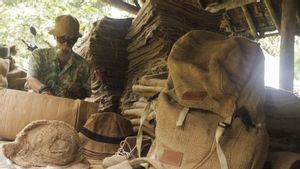JAKARTA - Indonesia's presidential palace often attracts the attention of the world. This magnificent building is multifunctional. From the residence of the president to welcoming state guests. Therefore, all political agendas are often perpetuated in various state-owned palaces. Its characteristics are relatively the same, like the past state palaces. Art performances and parties are the main activities. But now conditions are different. The Presidential Palace, which is generally old, is considered haunted. That said, there are many ghosts: imported and domestic ghosts.
Palace is something that is often associated with beauty and splendor. Sometimes it is also interpreted as "house gedongan," as the Betawi people say. Maybe there is nothing wrong with that view.
However, according to the Big Indonesian Dictionary (KBBI) it reveals the official meaning of the palace. That is, the palace is nothing but the official residence of the king (head of state, president) and his family. Because of that, everything related to activities to perpetuate the power of the palace has been going on since time immemorial. The Kingdom of the Archipelago has preserved it. Then the Dutch colonial government followed suit.
The Dutch colonial government is known as the culprit. Especially the Governor General. The ruler of the colony was like a true party lover. He often held dance parties to show his power. The alias is a show off. Show off hospitality, treasures, to art collections. The governor-general's habit of partying was written about by travelers who had visited the Dutch East Indies.
Justus Van Maurik, one of them. The writer from Amsterdam was also invited by the Governor-General of the Dutch East Indies to attend a banquet and dance party at the Paleis Rijswijk or Rijswijk Palace (now: the State Palace). The party invitation was not wasted by him. He came to Paleis Rijswijk in his best suit. He was also impressed by the friendliness of the leader of the colony.
“In front of the brightly lit palace, the small carriage unloaded its passengers before sliding into the parking lot at the back. When we entered, the room was illuminated by crown-shaped gas lamps and candles from the chandelier. The garden is filled with colorful lanterns. If it weren't so hot, we'd be in a dance hall in Paris, with beautiful women dressed in brocades, satins, silks, and sparkling jewellery."
"I'm impressed, but unfortunately my leg hurts a lot. Pushed by so many people, I couldn't stop to check my feet. Finally, it was my turn to shake hands with the Governor-General, he turned out to be friendly. After talking for a while, His Majesty left our place," said Justus van Maurik in the book Ketoprak Betawi (2001).
The habit of the governor-general of the Dutch East Indies holding a party did not only take place at Paleis Rijswijk. Invitations to dance parties and dinner parties are often also held at Paleis Buitenzorg or Buitenzorg Palace (now: Bogor Palace). At that time, a traveler from England, Charles Walter Kinloch who got the opportunity.

He visited the Dutch East Indies in 1852. The journey was pleasant. The goddess of luck was on Kinloch's side. He, who was the first to set foot in the Dutch East Indies, immediately received a party invitation from the colonial rulers.
The invitation came directly from the Governor-General of the Governor-General of the Dutch East Indies, Albertus Jacobus Duymaer van Twist (1851-1856). The once-in-a-lifetime opportunity made an impression on him. In other words: unforgettable.
“We found everyone present standing, the women standing in a row on one side of the room, and the men on the other; Before long, a door opened from the far end of the reception hall, and the Governor-General and his wife walked slowly toward the room. The women and men immediately retreated, the women showed respect, and the men bowed, as their majesty passed through the ranks of men and women. The secretary then walked forward and formally introduced ourselves and the female members on our way to the hostesses.”
“At dinner we had the honor of being seated next to the governor's wife, 'vis-a-vis' with our female travel companion, who sat to the left of the governor. The conversations were conducted partly in Dutch, and partly in French. His Majesty seems a bit embarrassed to speak English, even though he seems to have sufficient knowledge of the language,” said Charles Walter Kinloch in the book Rambles in Java: Wandering in the Land of Java (2019).
Palace ghostsThe gleam of welcoming guests in the style of the Dutch colonial government continued until Indonesia's independence. This condition was due to the fact that the Palace, which was once owned by the Governor-General of the Dutch East Indies, was taken over by the Indonesian government. In total, Indonesia has six presidential palaces: the State Palace, Bogor Palace, Tampaksiring Palace, Cipanas Palace, and Pelabuhan Ratu Palace.
A new problem arose. Most of the presidential palaces in fact have entered old age. Rumors arose after that. Through word of mouth among the presidential staff, the palaces are haunted.

That said, each presidential palace has a ghost. The spirits often frighten the palace dwellers. Especially, the State Palace. There, everyone had witnessed the presence of Dutch noni-noni around the State Palace.
Bogor Palace did not want to lose. Once upon a time in the palace there were many collections of high art objects. The stone statue in the form of a woman "Endang Teratai" by Edhi Sunarso (a Welcome & Pancoran Sculpture artist) is included. The statue often disappears from its location on certain nights. However, the disappearance of the Endang Lotus statue is sometimes not alone. The Endang Lotus statue is usually lost along with the bronze statue “Rindu” by Swedish artist P. Hasselberg. Likewise at the Cipanas Palace.
"In the wide garden of the Cipanas Palace, on certain nights at full moon, it is said that sometimes a very beautiful woman passes by in traditional Sundanese clothes. The woman walked restlessly and curiously, with a disappointed and angry posture. Those who believe this story then relate it to the history of the relationship between the Kingdom of Pajajaran and Majapahit in the 14th century. It is estimated that the beautiful woman is Dyah Pitaloka, daughter of Sri Baduga Maharaja, king of Pajajaran in the Sunda region," explained Agus Dermawan T. in the book Carnival Sahibulhikayat (2021).
The form of Dyah Pitaloka was initially considered to be fond of wandering around Pelabuhan Ratu. Then, later appeared at the Cipanas Palace. The condition was not much different from the haunted atmosphere in the palace that seemed siring. The palace, which was Soekarno's favorite place to compose his speeches, had scary rumors. Many leak-type ghosts are present there.
What's more, the palace seems to have a lot of tall works of art in the form of statues. By many people, the statues are considered as the main medium for the entry of spirits. Because that on a certain night, it is said that many who saw the statues while alive and made a sound.
Many also believe in ghost rumors in the presidential palace. Many also think that the presence of ghosts is only lonely. Kristen Herrawati or better known as Ani Yudhoyono is one of them.
The First Lady of the 6th President of Indonesia, Susilo Bambang Yudhoyono, cannot believe the many ghosts that haunt the presidential palace. Instead of being afraid of ghosts, Ani Yudhoyono has made the six presidential palaces the most memorable places to study history. Many historical objects and works of art of great value are present throughout the presidential palace.
“In fact, thanks to the guidance from the Presidential Secretariat team, I was finally compelled to look for books about the presidential palace in Indonesia. I became aware of various things around the palace. Wow, awesome. It is truly extraordinary the history behind the existence of the six presidential palaces that we have. The house that is a mirror of the authority of the country."
“A building that records centuries of history. That's great. So, why be afraid of ghosts? In fact, I was challenged to walk through other palaces and stay there!” closed Ani Yudhoyono as written by Alberthiene Endah in the book 10 Years of the Heart's Journey (2018).
*Read other information about HISTORY or read other interesting articles from Detha Arya Tifada.
Other MEMORIESThe English, Chinese, Japanese, Arabic, and French versions are automatically generated by the AI. So there may still be inaccuracies in translating, please always see Indonesian as our main language. (system supported by DigitalSiber.id)









